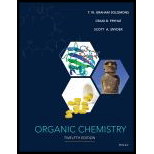
Interpretation:
The products obtained when the given terpenes are subjected to ozonolysis and then treated with dimethyl sulphide are to be determined.
Concept Introduction:
>The essential oils are odoriferous chemicals that are extracted from plants by heating or distillation. These essential oils have important chemical composition of hydrocarbons called terpenes and oxygen-containing compounds called terpenoids. The monoterpene unit is made up of two or more 5-Carbon atoms.
>The ozone is a powerful oxidant and the terpenoid
The ozonolysis of myrcene produces 1 mol of monoterpene, 2 mols of formaldehyde, and 1 mol of acetone.
>The limonene undergoes ozonolysis and reduction process to yield the products, 1 mol of formaldehyde and 1 mol of monoterpene.
>The
The geraniol undergoes ozonolysis followed by reduction reaction by dimethyl sulphide to produce 1 mol of a primary carbonyl (acetone), 1 mol of a secondary carbonyl (aldehyde-keto group), and 1 mol of glyoxal (ethanediol).
>The products formed by the reaction of ozone and dimethyl sulphide with squalene are 2 mols of acetone, 1 mol of hydroxy-aldehyde, and 4 mols of a ketal.
Want to see the full answer?
Check out a sample textbook solution
Chapter 23 Solutions
EBK ORGANIC CHEMISTRY
- Show the resonance forms for the enolate ions that result when the following compoundsare treated with a strong base.(a) ethyl acetoacetate (b) pentane-2,4-dione(c) ethyl a@cyanoacetate (d) nitroacetonearrow_forwardEach of the following reactions has been carried out under conditions such that disubstitution or trisubstitution occurred. Identify the principal organic product in each case. (a) Nitration of p-chlorobenzoic acid (dinitration) (b) Bromination of aniline (tribromination) (c) Bromination of o-aminoacetophenone (dibromination) (d) Bromination of p-nitrophenol (dibromination) (e) Reaction of biphenyl with tert-butyl chloride and iron(III) chloride (dialkylation) (f) Sulfonation of phenol (disulfonation)arrow_forwardThe following questions pertain to the esters shown and behavior under conditions of the Claisen condensation.(a) Two of these esters are converted to β-keto esters in good yield on treatment with sodium ethoxide and subsequent acidification of the reaction mixture. Which two are these? Write the structure of the Claisen condensation product of each one. (b) One ester is capable of being converted to a β-keto ester on treatment with sodium ethoxide, but the amount of β-keto ester that can be isolated after acidification of the reaction mixture is quite small. Which ester is this? (c) One ester is incapable of reaction under conditions of the Claisen condensation. Which one? Why?arrow_forward
- (c) The sedative, R-thalidomide, was once used to address symptoms of morning sickness in expectant mothers, however, when it was discovered that S- thalidomide causes deformities in infants, the use of R-thalidomide as a sedative was discontinued. With the help of a reaction mechanism, explain why enantiopure R-thalidomide can not be safely used as a sedative without affecting infantsarrow_forwardPractice Problem 19.54 Z Your answer is partially correct. Try again. Predict the major product(s) (A - K) from the treatment of acetone with the following compounds (a-c): NH2 HO Eto OEt A: B: C: D: E: F: OH OH но CN G: H: I: J: (a) [H*], excess EtOH, (-H20) Major Product(s): (ь) NaBH4, Meон B Major Product(s): (c) LAH followed by H20 Major Product(s): SHOW HINTarrow_forwardShow how you would synthesize the following esters from appropriate acyl chloridesand alcohols. (c) benzyl benzoate (d) cyclopropyl cyclohexanecarboxylatearrow_forward
- Rank the compounds in each of the following groups in order of their reactivity to electrophilic substitution: (a) Nitrobenzene, phenol, toluene, benzene (b) Phenol, benzene, chlorobenzene, benzoic acid (c) Benzene, bromobenzene, benzaldehyde, anilinearrow_forwardGive the structure of the product formed on reaction of ethyl acetoacetate with each of the following: (a) 1-Bromopentane and sodium ethoxide (b) Saponification (basic hydrolysis) and decarboxylation of the product in part (a) (c) Methyl iodide and the product in part (a) treated with sodium ethoxide (d) Saponification and decarboxylation of the product in part (c) (e) 1-Bromo-3-chloropropane and one equivalent of sodium ethoxide (f) Product in part (e) treated with a second equivalent of sodium ethoxide (g) Saponification and decarboxylation of the product in part (f) (h) Phenyl vinyl ketone and sodium ethoxide (i) Saponification and decarboxylation of the product in part (h)arrow_forward(a) Explain why an alkylamine is more basic than ammonia?(b) How would you convert(i) Aniline to nitrobenzene (ii) Aniline to iodobenzenearrow_forward
- (c) Treating lactone B with two equivalents of phenylmagnesium bromide, followed by hydrolysis in aqueous acid, gives a compound with the molecular formula C18H22O2, as shown below. Propose a structural formula for this compound. 1. PhMgBr (2 eq.) 2. H'/H>O C18H2202 bj 1o 14 10I f6 40 & 3 4 00 (8)arrow_forward(a) Give a plausible explanation for each one of the following :(i) There are two – NH2 groups in semicarbazide. However, only one such group is involved in the formation of semicarbazones.(ii) Cyclohexanone forms cyanohydrin in good yield but 2, 4, 6-trimethylcyclohexanone does not.(b) An organic compound with molecular formula C9H10O forms 2, 4, – DNP derivative, reduces Tollens’ reagent and undergoes Cannizzaro’s reaction. On vigorous oxidation it gives 1, 2-benzene-di- carboxylic acid. Identify the compound.arrow_forward(a) Write a suitable chemical equation to complete each of the following transformations :(i) Butan-l-ol to butanoic acid(it) 4-Methylacetophenone to benzene-1, 4-dicarboxylic acid(b) An organic compound with molecular formula C9H10O forms 2, 4-DNP derivative, reduces Tollen’sreagent and undergoes Cannizzaro’s reaction. On vigorous oxidation it gives 1, 2-benzenedicarboxylic acid. Identify the compound.arrow_forward

 Organic ChemistryChemistryISBN:9781305580350Author:William H. Brown, Brent L. Iverson, Eric Anslyn, Christopher S. FootePublisher:Cengage Learning
Organic ChemistryChemistryISBN:9781305580350Author:William H. Brown, Brent L. Iverson, Eric Anslyn, Christopher S. FootePublisher:Cengage Learning

